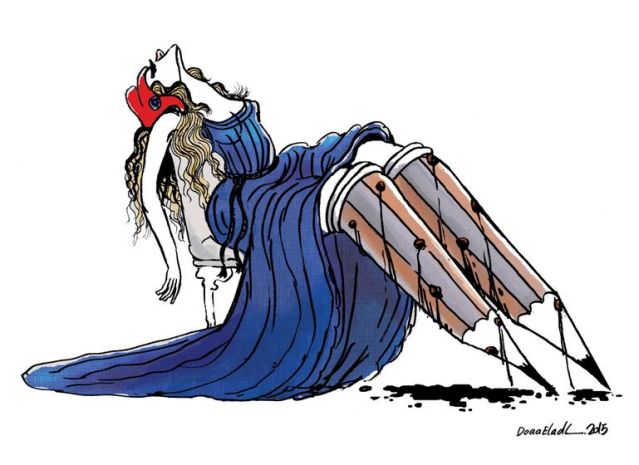Regression
Charlie Hebdo and Group Regression
Mental cultures of idolatry and satire.
Posted January 12, 2015
"Charlie Hebdo," by Egyptian cartoonist Doaa Eladl Attacks on illustrators of the French satirical magazine spur inquiry into some of the culturally-determined psychological elements behind the massacre. How does pictorial representation of Mohammed violate sacred taboo and incite a bloody scene where terrorists storm Charlie Hebdo screaming, “We avenge The Prophet!”

"Charlie Hebdo," by Egyptian cartoonist Doaa Eladl
Attacks on illustrators of the French satirical magazine spur inquiry into some of the culturally-determined psychological elements behind the massacre. How does pictorial representation of Mohammed violate sacred taboo and incite a bloody scene where terrorists storm Charlie Hebdo screaming, “We avenge The Prophet!”
"It's all rooted in the notion of idol worship," says Akbar Ahmed, Chair of the Islamic Studies department at American University. The prohibition against illustrating Mohammed began as an attempt to forbid idolatry, which was widespread in Islam's birthplace, Arabia. The idea being when one bows to an idol the person worships the image and not what the image represents. This is an “error of substitution” of the symbol for the thing symbolized, according to Moshe Halbertal and Avishai Margalit (Idolatry, Harvard, 1992). “This error is the very making of something that has no image.” (pgs. 42-5) This sounds like a foreign concept to many of us who believe in the ordinary right of free speech. But this process of substitution reminds me of what psychoanalysis calls "transference," a main component of its therapeutic cure. In Studies on Hysteria, Freud described transference as a “false connection” established when the symbolic expression of a childhood wish is transferred to the doctor or another person or thing in the present.
Psychoanalytst Don Carveth author of The Still Small Voice: Psychoanalytic Reflections on Guilt and Conscience (Karnac, 2013), reminds us "Hannah Segal distinguishes 'symbolic equation' where symbol and object are merged or identified, from 'symbolic representation' where the difference or separation is maintained. I think of the former as 'dead' or literalized metaphor and the latter as 'live' metaphor that operates essentially like simile: while the word 'like' is present in simile, in 'live' metaphor it is silently understood-- here in saying "argument is war" we mean it is only LIKE a war in some respects while differing in others. Idolatry, fundamentalism, ideology, etc., are composed of 'dead' or literalized metaphor or symbolic equation. But we are all literalists, fanatics, and fundamentalists when we are (not infrequently) operating in the paranoid-schizoid position. Islamist radicals have in no way cornered the market on idolatry!” These ideas are more fully elaborated in Carveth's paper on the analyst's metaphors.
In Western Europe, political cartooning goes back to Leonardo da Vinci and his explorations of deformity, even more, the grotesque in the human body. He filled notebooks with drawings of people with illnesses or facial deformities, which he studied to better understand our ideals of human beauty. Cartooning of a more editorial style developed with the Protestant Reformation in Germany, which satirized the Catholic Church and was crucial to Martin Luther's reforms because much of the population was illiterate.
Before the 20th century, perhaps there was less narcissistic rage over depicting Muhammed in offensive ways due to the geographic distance between the Muslim world and the West. Yet our age of globalization threatens large-group identities. Different systems of thought -- once sealed and separated -- now savagely collide.
______________
In memory of Elsa Cayat, a psychoanalyst and the only woman killed in the Charlie Hebdo massacre. Cayat wrote a column for the paper called "Charlie Divan" (Charlie's Couch) and was the author of the book Desire Et La Putain: Les enjeux cashés de la sexualité masculine ("Desire and Whore: The Hidden Stakes of Male Sexuality").
<><><>


